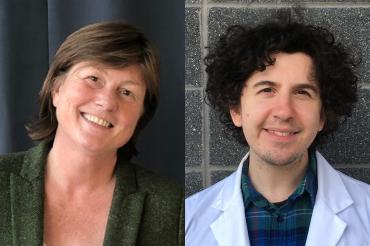Loss of key protein could be crucial to understanding ALS: Study

Published: March 31, 2023
Researchers at the University of Toronto have shown that loss of a key protein in amyotrophic lateral sclerosis (ALS) and frontotemporal dementia (FTD) may contribute to the underlying cause of both diseases.
The protein, known as C9orf72 (C9) and expressed by a gene with the same name, affects movement of molecules between the nucleus and the cytoplasm in the neurons affected in ALS and FTD, the researchers found.
“Here we have uncovered a role for C9orf72 in regulating nucleocytoplasmic transport, a crucial mechanism that causes cellular dysfunction if disrupted,” says Janice Robertson, a professor in the department of laboratory medicine and pathology in U of T’s Temerty Faculty of Medicine and scientist at the Tanz Centre for Research in Neurodegenerative Diseases.
The journal Cell Reports published the findings.
A mutation in the gene C9 is the most common genetic cause of ALS, found in about 40 per cent of familial cases and 10 per cent of sporadic cases. Mutations in this gene may cause disease in two different ways: gain of function, where the mutation leads to the creation of abnormal RNA and proteins; or loss of function, where the C9 protein is reduced, affecting its normal function.
While many research teams have focused on the gain-of-function mechanisms, Robertson’s lab has been studying what happens in cells when C9 protein is absent or reduced.
“Most of the research in the field has been done on the gain-of-function mechanisms, but recent clinical trials targeting these mechanisms have not been entirely successful, suggesting that gain-of-function mechanisms may not be the sole contributors to disease,” says Philip McGoldrick, a research associate in Robertson’s lab and first author on the study. “Our previous research has suggested that normal C9 protein levels could be protective against disease, and other researchers have shown that the gain-of-function mechanisms are exacerbated when C9 protein is lost; however, we don’t know through which pathways this modifying effect occurs.”
In the past, researchers have proposed that interruptions in the mechanism that shuttles molecules between the nucleus and the cytoplasm, known as nucleocytoplasmic transport, may be an underlying cause of ALS. And Robertson’s lab has previously uncovered that the C9 protein interacts with other molecules that are important in this transport system.
In their newest research, they focused specifically on how the loss of C9 affects nucleocytoplasmic transport. They used cell lines, motor and cortical neurons and animal models to visualize the activity of the key transport molecules when C9 was reduced or absent.
In each case, they were able to show that loss of the C9 protein affected nucleocytoplasmic transport such that important molecules and proteins that perform functions related to gene expression and translation are not where they should be.
“Previously, researchers thought that loss of function was having a very minor effect, but there’s been lots more work that has showed that you actually may need multiple mechanisms to result in disease,” says McGoldrick. “Our work makes an important contribution because it shows for the first time that loss of C9 can affect nucleocytoplasmic transport mechanisms that we know are also affected by the gain-of-function mechanisms.”
McGoldrick recently received a Career Transition Award from the ALS Society of Canada and Brain Canada that will support his continuing studies on the topic and help his transition to an independent research career in Canada. The award provides both salary support and research funding for three years.
“The Career Transition Award is a well-deserved accolade for Philip and exemplifies the importance of his research toward findings a cure for ALS and FTD,” says Robertson.
With the award, McGoldrick plans to continue studying transport between the nucleus and the cytoplasm and the nuclear pore – the structure through which transport takes place – to gain more insight into the underlying mechanisms of ALS and how the C9 protein may be involved.
“This is a massive boost to my career,” he says. “It will enable me to pursue this research for the next few years and will make a substantial contribution to what we know about C9 loss of function contributing to disease.”
The research was supported by the ALS Society of Canada, Brain Canada, the James Hunter ALS Initiative and ALS Double Play.



